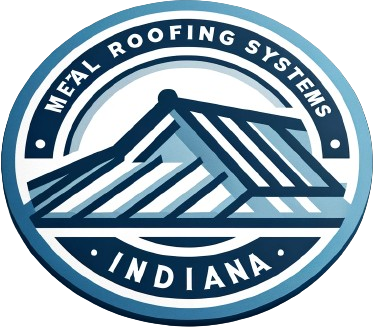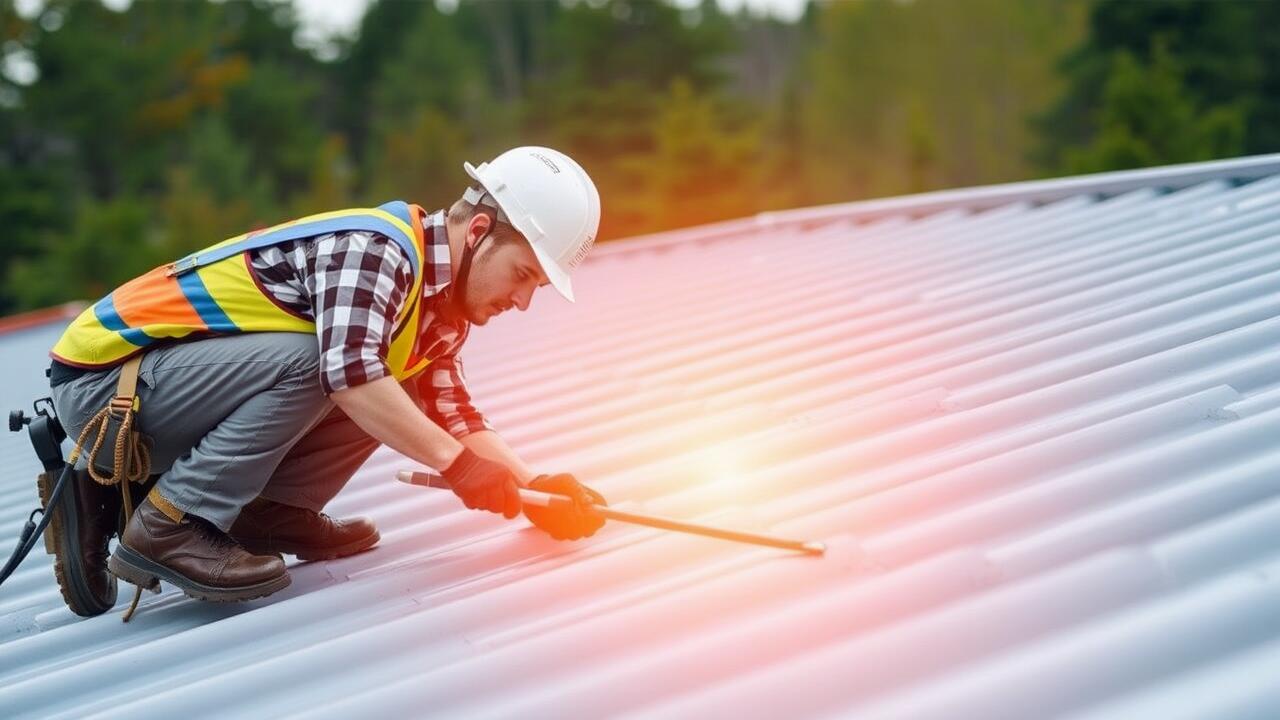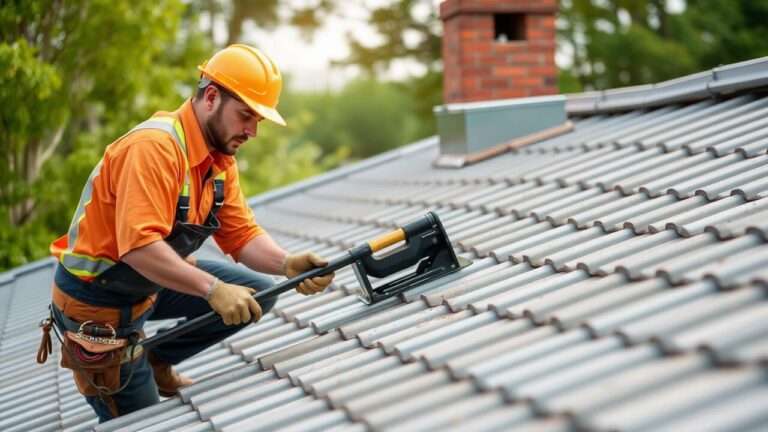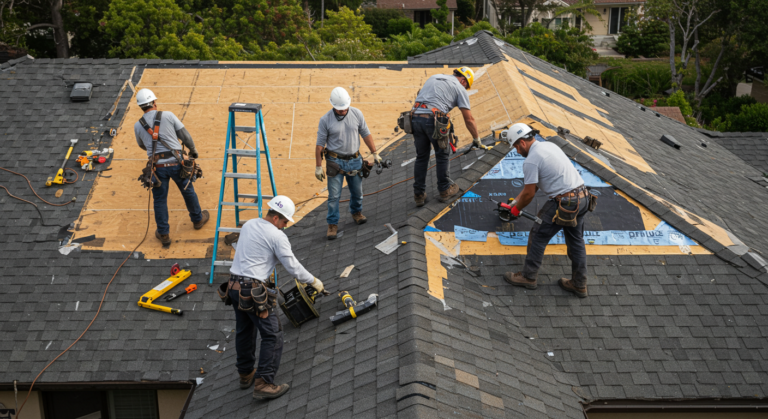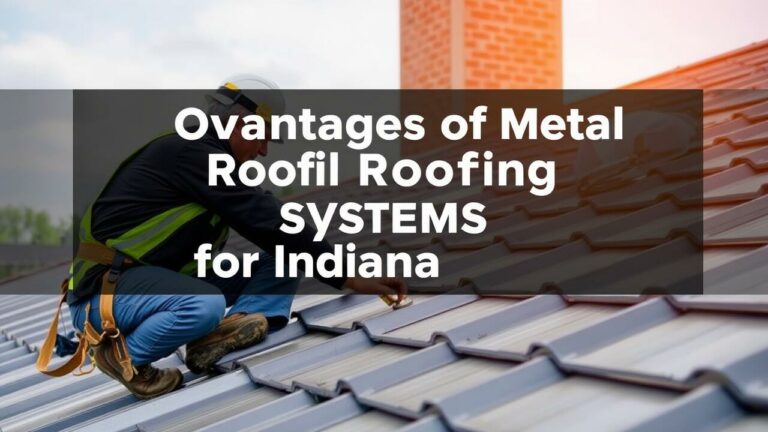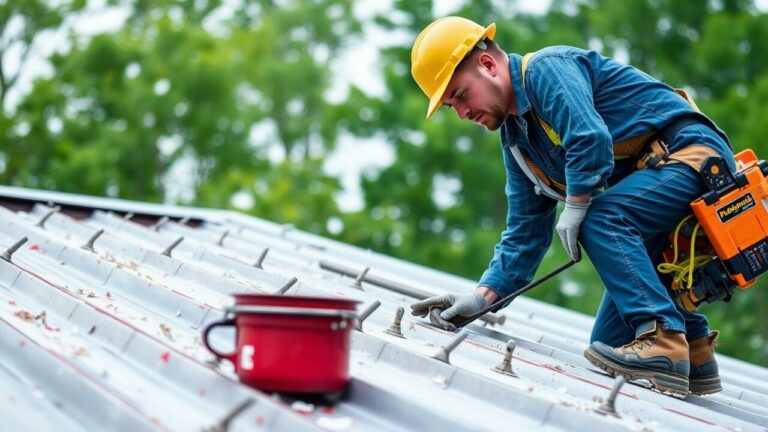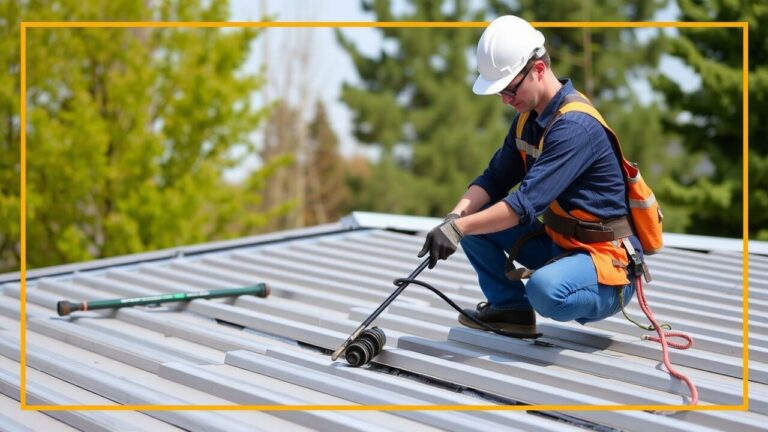Step-by-Step Guide to Installing Metal Roofing Systems in Indiana
A pivotal moment in the installation dance of metal roofing lies in the meticulous laying down of underlayment. This unsung hero acts as a formidable moisture barrier, staunchly guarding the roof deck against unwelcome water infiltration. In places like Indiana, where weather whims can swing wildly from sunshine to storm, investing in top-notch underlayment becomes not just wise—it’s essential! It plays a crucial role in thwarting leaks while also cranking up insulation levels, thereby bolstering the building’s overall energy efficiency.
Now, when it comes time to install this vital layer, attention to detail is key; ensuring that each sheet overlaps properly is non-negotiable. This strategic overlap forges a watertight seal that dramatically curtails any chance of water sneaking through those seams. Start your journey at the lowest point of the roof and work your way skyward, applying that underlayment with precision so it channels water away from beneath those sturdy eaves. Fastening it down securely will lay an unshakeable foundation for those gleaming metal panels above—a decision destined to amplify both performance and longevity within the roofing system’s grand design.
Importance of Underlayment in Metal Roofing
Underlayment—an unassuming yet pivotal player in the realm of metal roofing installations. It stands as a formidable shield, thwarting the relentless encroachment of moisture. This seemingly simple layer significantly bolsters the resilience of your roofing system, warding off water damage and extending the lifespan of those crucial structural components lurking beneath that gleaming exterior. When expertly laid down, underlayment doesn’t just stop at protection; it also steps up to enhance energy efficiency by injecting an extra dose of insulation into the equation.
But wait—there’s more! Underlayment is not merely a passive barrier; it actively defends against nature’s unpredictable tantrums, be it fierce winds or merciless hail storms. By minimizing condensation buildup—a sneaky culprit that can precipitate rust and gradual decay over time—it plays an essential role in maintaining integrity. Choosing the right flavor of underlayment, whether breathable or synthetic, becomes paramount for unlocking your metal roof’s full potential while ensuring it’s primed to tackle Indiana’s unique climate challenges head-on.
| Type of Underlayment | Key Features | Best Use Cases |
|---|---|---|
| Breathable Underlayment | Allows moisture vapor to escape, reducing condensation | Ideal for climates with high humidity and temperature fluctuations |
| Synthetic Underlayment | Durable, lightweight, and resistant to UV rays | Great for areas with heavy precipitation and high winds |
| Felt Underlayment | Cost-effective and provides additional insulation | Commonly used for traditional roofing systems and in mild climates |
| Self-Adhesive Underlayment | Offers excellent waterproofing and is easy to install | Recommended for low-slope roofs and areas prone to ice damming |
Laying the Metal Panels
The meticulous arrangement of those metal panels? Absolutely pivotal for crafting a roof structure that stands the test of time! Start by placing the inaugural panel right at the edge, allowing it to hang just a tad over the eaves—this little maneuver is key for proper water drainage. Then, tap into those pre-drilled holes or designated fastening points as you position each subsequent panel, ensuring they overlap consistently where needed. This careful alignment acts like a guardian against gaps that could invite pesky water infiltration and usher in structural headaches down the road.
As you lay each panel down, don’t forget to keep an eagle eye on straightness; leveling is non-negotiable here! A trusty chalk line can work wonders—drawing clear guidelines across your roof surface will help maintain that precise alignment. And let’s not overlook those fastening points: make sure they’re snug without compromising the integrity of your panels! Any misalignment now? It could spell disaster later on, affecting both aesthetics and functionality of your roofing masterpiece—and trust me, nobody wants to face massive repairs in their future!
Techniques for Proper Panel Alignment
Achieving the elusive perfection of panel alignment—oh, how crucial it is for both the integrity and sheer aesthetic allure of your metal roofing system! Picture this: you commence with a clear starting point; that first panel must be nothing short of straight and level. Grab a chalk line—your trusty visual companion—and mark those reference points along the entire length of the roof. This guide becomes your north star, steering you toward uniformity as each subsequent panel follows in lockstep, effectively reducing any chances of misalignment as you dive deeper into installation.
Now, as you attach those panels, make sure they fit together like pieces in a puzzle—snugly, without gaps or annoying overlaps. Each one should interlock flawlessly with its neighbors to stave off pesky water infiltration while bolstering structural strength. Ah, but here’s a tip: use temporary fasteners during those initial moments; they grant you the freedom to tweak things just right before making everything permanent. Once you’re satisfied with that glorious alignment? Secure them down using proper fasteners according to what the manufacturer prescribes for spacing and placement. This painstaking dedication will yield not only durability but also an eye-catching metal roofing installation that turns heads!
Securing the Metal Roofing Panels
Nailing down metal roofing panels isn’t just a task; it’s an art form, vital for their endurance and ability to brave the whims of Mother Nature. First off, you need to choose fasteners—those little heroes engineered specifically for metal roofs. Opt for corrosion-resistant ones, especially given Indiana’s ever-changing climate that swings from sunny skies to torrential downpours.
Now comes the alignment dance: position those fasteners like a pro, snugging them up with the predetermined seam lines. This meticulous placement is your ticket to stability city, where leaks are nothing but a distant memory.
Once you’ve laid down the panels in all their shiny glory, it’s time to crank those fasteners tight—just enough to meet the manufacturer’s torque specs. This step is crucial; over-tightening could spell disaster while under-tightening invites chaos. Don’t forget about washers! These nifty little rings act as extra shields against moisture trying sneak its way in.
By executing these strategies with precision and care, you’ll not only boost performance but also extend the lifespan of your metal roofing system—a true win-win!
Fastening Methods and Best Practices
Ah, the world of metal roofing—where proper fastening wields the power to dictate durability and performance! Picture this: the choice of fasteners isn’t just a mundane decision; it’s an intricate dance that hinges on the type of metal panels at play. Yet, in this choreography, self-tapping screws often emerge as star players. Why? Because they forge a tight seal against pesky water intrusion while gracefully accommodating thermal expansion and contraction—a true balancing act!
And let us not overlook those trusty washers crafted from rubber or neoprene. They are like guardian angels for your installation, elevating its weatherproofing prowess and adding layers of defense against leaks lurking in shadows.
Now, best practices beckon! Fasteners must be installed at intervals meticulously prescribed by the manufacturer—like notes in a symphonic score. Adhering to consistent patterns does more than uphold structural integrity; it skillfully distributes weight across panels like an expert juggler maintaining balance under pressure. But heed this caution: over-tightening is a treacherous path! It can inflict damage on your precious panels, undermining their very effectiveness.
Fear not—the journey doesn’t end here! Regular inspections and maintenance are crucial allies in your quest for longevity. Focus keenly on the condition and placement of those fasteners; they hold secrets vital to preserving your metal roofing system through time’s relentless march.
Installing Flashing and Trim
Flashing and trim—oh, how they dance in the intricate ballet of metal roofing! They don’t just play their parts; they take center stage, ensuring that every inch of your roof remains watertight and impeccably finished. Think about it: proper installation isn’t merely a task; it’s a strategic maneuver to shepherd water away from those oh-so-vulnerable spots, warding off leaks that could gnaw at the very structure beneath. But where do we deploy this flashing magic? Ahh, around chimneys like sentinels, through roof valleys as conduits for runoff, and at those critical intersections with vertical walls.
Now let’s talk materials—the high-quality kind specifically crafted for metal roofs. This is not just an upgrade; it’s an investment in longevity and performance that pays dividends over time.
But hold on! The installation process demands meticulous attention—a symphony of precision! Flashing must be expertly cut to embrace the contours of the roof while being laid out in such a manner as to facilitate optimal drainage. And what about sealants? These little heroes step in at seams and joints, bolstering waterproof defenses like armor against moisture intrusion.
As for trim pieces—they’re not mere afterthoughts but rather essential elements installed post-flashing to bestow upon your roof that sleek, professional flair. Aligning these components perfectly is paramount; secure them well so your roof can stand resilient against time’s relentless march.
Areas Requiring Flashing for Optimal Performance
Flashing is absolutely vital in steering water away from those exposed spots on a metal roofing system, where vulnerabilities lurk. Think about it: roof hips and valleys—those intricate intersections of two planes—are prime candidates for water infiltration if not properly protected. And let’s not forget the wall joints! Where the roof meets vertical surfaces, flashing becomes an essential barrier against leaks that can sneak in unnoticed.
But wait, there’s more! Areas surrounding chimneys, vent pipes, and skylights demand meticulous attention too; these are hotspots where watertight seals must be flawlessly executed to uphold the structure’s integrity.
Now, when it comes to installing this crucial component, using high-quality materials is non-negotiable—they need to match the rugged durability of the metal roofing itself. Flashing should nestle snugly into the roofing underlayment and be securely affixed to minimize any risk of pesky water seepage. The alignment? Oh yes, that’s key: flashing ought to extend beyond the edge of your roofing material like a protective shield designed specifically to redirect water away with precision.
And here’s a pro tip: make regular inspections part of your maintenance routine post-installation! This diligence will catch potential issues early on—an approach that ultimately prolongs both flashings’ lifespan and that robust roofing system you’ve invested in so carefully.
- Properly install flashing at roof hips and valleys to prevent water pooling.
- Ensure wall joints are thoroughly flashed to protect against leaks.
- Pay special attention to areas around chimneys to maintain watertight seals.
- Flashing should be applied around vent pipes and skylights for added protection.
- Use high-quality flashing materials that resist corrosion and wear over time.
- Regularly inspect and maintain flashing to identify potential issues before they escalate.
- Make sure flashing extends beyond roofing edges to effectively redirect water away.
Final Inspection and Maintenance
Once the installation of your metal roofing system is wrapped up, diving into a meticulous inspection becomes paramount—an absolute must to confirm that every single component is operating like a well-oiled machine. Start by scrutinizing for any sneaky gaps or misalignments lurking between the panels; these little troublemakers could usher in leaks or instigate structural dilemmas down the line. Don’t overlook those seams and fasteners—give them a good once-over to ensure they’re tightened snugly. Turn your attention to the flashing and trim as well: any signs of damage or wear here are red flags, given their vital role in channeling water away from potential entry points.
To keep this roofing marvel standing strong through the years, embrace routine maintenance with open arms! Ideally, pencil in inspections at least biannually—especially before and after Mother Nature unleashes her fury. During these check-ups, don’t forget to banish debris like leaves and branches from both the roof surface and gutters—they can wreak havoc if left unchecked. Keep an eagle eye out for rust or corrosion; addressing these issues swiftly will be key to preserving your roof’s integrity. Maintaining cleanliness and ensuring no build-up occurs will dramatically bolster its performance and longevity—your roof deserves nothing less!
Routine Checks for Longevity
Regular inspections—oh, how crucial they are! They serve as the lifeblood for the longevity of your metal roofing system. Homeowners ought to mark their calendars and schedule these essential check-ups at least twice a year, ideally in that sweet spot between spring’s rebirth and fall’s farewell. During each inspection, keep your eyes peeled for telltale signs of rust creeping in, fasteners trying to escape their duties, or any pesky debris that dares obstruct water’s graceful descent. Don’t overlook those joints and seams; they’re notorious hotspots where leaks like to sneak in over time.
But wait—there’s more! Maintenance doesn’t stop at mere inspections; it demands a good cleaning too! Sweep away those leaves, branches, and other unwelcome guests cluttering up the roof surface. This not only keeps drainage flowing smoothly but also slashes the odds of mold and algae throwing a party up there. And let’s not forget: after any fierce weather event—be it rainstorm or snow flurry—it pays off handsomely to inspect every nook and cranny for immediate concerns begging for attention.
This regular upkeep? It does wonders—not just amplifying your roof’s aesthetic charm but also boosting its overall functionality. In doing so, you ensure that your investment remains standing strong through many seasons yet to come!
Conclusion
Installing a metal roofing system successfully is no small feat; it demands meticulous attention to detail and an unwavering commitment to industry best practices. Homeowners, by meticulously following the outlined steps, can transform their roofs into not just visually striking elements but also robust shields against Indiana’s capricious climate. The journey begins with proper preparation—selecting top-tier materials and employing effective fastening techniques—which plays a pivotal role in boosting the overall performance and lifespan of that shiny new roof.
But wait! The story doesn’t end once installation wraps up. Ongoing maintenance and periodic inspections are the unsung heroes in maintaining the integrity of metal roofs over time. It’s imperative for homeowners to prioritize these check-ups, catching potential issues before they snowball into costly repairs. This vigilance ensures that your investment remains safeguarded for years on end. With dedication and thoughtful care, a well-installed metal roofing system isn’t just about protection; it’s about elevating both the allure and value of your cherished home!
